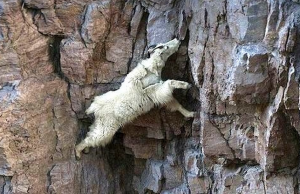Goats climb thanks to their specially adapted hooves, a feature that greatly aids their survival and makes them quite peculiar sights to see!
Mountain goats are extraordinary creatures, capable of climbing extraordinarily steep walls and jumping extraordinary heights. In fact, National Geographic claim that they can jump as high as 12 feet! This is thanks to their marvelously strong leg muscles, leg muscles that also mean mountain goats climb with as much ease as they walk!
Their hooves are two-toed and cloven, with pliable padding and a tough ‘outer shell’. These rubbery pads are able to spread apart, greatly improving the goat’s ability to balance and strengthening their grip. Their grip and overall strength is also helped by their aforementioned leg muscles, more specifically their front legs. Another great adaptation found in goats that enable them to climb so high is their thick coats! This dense layer of fur traps heat in, allowing the goat to keep nice and warm at high altitudes. It also repels water!

In case you’re wondering why its important that goats climb so high, there are a number of great evolutionary benefits. For a start, it enables them to escape out of reach from predators such as mountain lions and cougars that they would be vulnerable to on the ground. Climbing also enables them to reach high up shrubbery and other food sources, they’re even reported to enjoy licking rocks for salt! Now all they need is a pepper grinder!
Goats are remarkable at climbing, but now let’s discuss some other great climbers from the animal kingdom!
Other climbing animals
We can’t really discuss climbing without talking about the O.G. wall crawlers: spiders. Spider legs are covered in hundreds upon hundreds of tiny hairs, each of which is covered in even smaller hairs! These tiny hairs are called ‘setules’ and only about a hundred nanometers thick (for reference, a nanometer is one 10,000,000th of a centimeter). Setules have a specialized triangular tip that helps spiders cling to/climb walls. Imagine very tiny, built-in ice picks.

Sloths are an interesting case, as their claws are 8-10cms long which makes them remarkable climbers. They spend almost all their time in the canopies of trees and travel between trees using vines. One issue is their long claws make them incredibly, unbelievably slow at travelling on land. This means they only leave trees about once a week to defecate, a process that usually makes them lose one third of their body weight!
Monkeys are infamous for their ability to climb. Much like humans, monkeys have thumbs and this makes their grip strength incredible on both their hands and feet!. Their bone structure is also much more flexible than that of a human, making them much more agile and acrobatic. They are able to use their tails for extra grip by wrapping them around trees like pieces of rope. In general, monkeys are built for climbing and learn to do so from a young age. This means that they seem almost perfectly designed for climbing, a trait that doesn’t seem to be shared by goats at first glance. But, as you now know, goats climb and they climb BRILLIANTLY.

Extra information
Animal-Club provides animal parties or animal handling workshops. You will be able to see, learn and interact with many wonderful animals with the help of our presenters. Our mobile zoo has many friendly animals such as rabbits, tarantulas, geckos, vinegaroons and more, perfect for an animal party. We can also come over to your school for an animal school visit or arrange for an animal workshop with us where the children can learn about looking after animals and animal behaviour, and have fun too.



